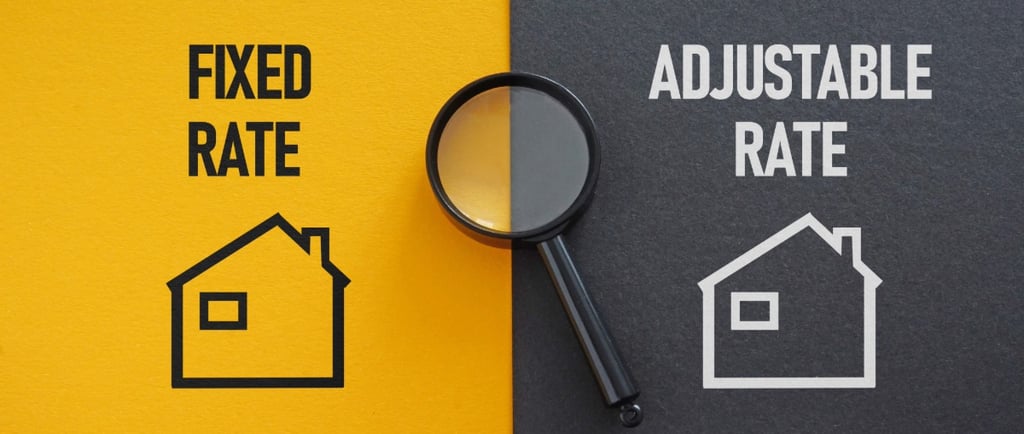Fixed-Rate Mortgage vs Adjustable-Rate Mortgage: Which One Should You Choose?
Explore the differences between fixed-rate and adjustable-rate mortgages to find the best loan option for your financial goals and lifestyle.
12/24/20244 min read


Choosing the right mortgage is one of the most critical decisions in your home-buying journey. With so many loan options available, it’s easy to feel overwhelmed. However, two of the most common mortgage types that borrowers consider are fixed-rate mortgages (FRMs) and adjustable-rate mortgages (ARMs). Each has its distinct structure, benefits, and potential drawbacks.
In this blog, we’ll walk you through both loan types in depth, helping you make an informed decision based on your financial goals, lifestyle, and market conditions. Whether you're a first-time buyer or a seasoned investor, understanding the pros and cons of a fixed-rate mortgage vs adjustable-rate mortgage can make all the difference.
Understanding Fixed-Rate Mortgages
A fixed-rate mortgage is a home loan with an interest rate that remains constant for the entire term of the loan. Whether you choose a 15-year or 30-year term, your monthly principal and interest payments stay the same throughout. This predictability makes fixed-rate mortgages one of the most popular choices among homebuyers, especially those seeking long-term financial stability.
Key Benefits of Fixed-Rate Mortgages:
Predictability: Monthly payments are consistent, making it easier to budget without surprises.
Long-Term Stability: You're shielded from market interest rate increases, regardless of fluctuations.
Peace of Mind: Especially beneficial for those planning to stay in their homes long term, offering financial security.
Potential Drawbacks:
Higher Initial Rates: Typically starts with a higher interest rate compared to ARMs.
Less Flexibility: If interest rates drop significantly, you won’t benefit unless you refinance.
Long-Term Cost: You may pay more over the life of the loan if rates remain low.
Understanding Adjustable-Rate Mortgages (ARMs)
An adjustable-rate mortgage starts with a lower fixed interest rate for an introductory period—usually 5, 7, or 10 years. After that period, the rate adjusts annually based on an index tied to market performance, plus a margin determined by the lender.
For example, a 5/1 ARM means you get a fixed rate for five years, followed by yearly adjustments. The initial rate is usually lower than a fixed-rate loan, making ARMs attractive to short-term homeowners.
Key Benefits of ARMs:
Lower Initial Payments: Ideal for buyers who want to keep early costs down.
Good for Short-Term Ownership: Perfect for buyers planning to move, sell, or refinance within a few years.
Potential for Lower Rates: If market rates decline, your adjustable rate may decrease as well.
Potential Drawbacks:
Uncertainty: After the fixed period, your rate and payments may increase, sometimes significantly.
Budgeting Challenges: Variable payments make it harder to plan monthly finances.
Complex Terms: Understanding caps, indexes, and adjustment intervals requires careful attention.
Fixed-Rate Mortgage vs Adjustable-Rate Mortgage: Choosing the Right Loan
The decision between a fixed-rate and adjustable-rate mortgage depends on several key factors:
1. Duration of Homeownership
Choose a fixed-rate mortgage if you plan to stay in your home for more than 7 years. It offers long-term security.
Opt for an ARM if you plan to move, sell, or refinance within a shorter time frame.
2. Risk Tolerance
A fixed-rate is ideal for conservative borrowers who prefer certainty.
An ARM suits those who can handle some risk and want to benefit from lower initial rates.
3. Market Interest Rate Trends
Lock in a fixed-rate if rates are currently low and projected to rise.
Consider an ARM if current rates are high but expected to decrease, potentially saving on interest.
4. Financial Situation
A fixed-rate mortgage is recommended if your income is stable and you prioritize financial security.
An ARM may be a good fit if you're early in your career with expected income growth.
5. Long-Term Goals
Fixed-rate mortgages support long-term residence and consistent cash flow.
ARMs offer flexibility and initial affordability for buyers with evolving housing plans.
Real-Life Scenario
Imagine a young professional purchasing their first condo with plans to relocate for work in five years. A 5/1 ARM could save them thousands in interest payments during the initial fixed period. Since they don’t expect to stay beyond that term, the risk of rate increases is minimal.
On the other hand, consider a family buying their forever home. They plan to live there for decades and want payment stability. A 30-year fixed-rate mortgage would offer predictable payments, allowing them to budget with confidence and avoid future rate shocks.
Frequently Asked Questions (FAQs)
Q: Can I switch from an ARM to a fixed-rate mortgage later?
A: Yes, through refinancing. If market rates are favorable and your financial situation is solid, converting to a fixed rate can be a smart long-term move.
Q: What are mortgage rate caps in ARMs?
A: Caps limit how much your interest rate can increase in a year (periodic cap) and over the life of the loan (lifetime cap), protecting you from extreme spikes.
Q: Is a fixed-rate mortgage always more expensive?
A: Not necessarily. While the initial interest may be higher, fixed-rate loans offer protection from future rate hikes, which can be valuable over time.
Q: Can first-time buyers benefit from ARMs?
A: Yes, especially if they plan to upgrade to a larger home in a few years or expect to relocate. However, they should fully understand the adjustment terms.
Final Thoughts
There is no one-size-fits-all mortgage. The choice between a fixed-rate mortgage vs adjustable-rate mortgage depends entirely on your personal and financial goals. Fixed-rate mortgages offer consistency, predictability, and long-term peace of mind. In contrast, ARMs offer lower initial costs and flexibility but require a tolerance for potential changes in monthly payments.
Before making your decision, evaluate your risk tolerance, length of stay, income trajectory, and current market conditions. Most importantly, consult with a qualified mortgage advisor who can analyze your situation and recommend the best fit for your needs.
Whether you're a first-time homebuyer or a seasoned real estate investor, the mortgage you choose can shape your financial future. Make sure it's one that aligns with your lifestyle, goals, and budget—because the right mortgage today could lead to lasting security and financial success tomorrow.
By understanding the core differences between a fixed-rate mortgage vs adjustable-rate mortgage, you'll be empowered to choose a loan that supports your financial goals and homeownership dreams.
Hello, I’m Danny Bertolini, Vice President at Meadowbrook Financial Mortgage Bankers Corp.
Useful Links
Subscribe to our newsletter
© 2025 Danny Bertolini. All Rights Reserved. | Meadowbrook Financial Mortgage Bankers Corp. | NMLS #167666
